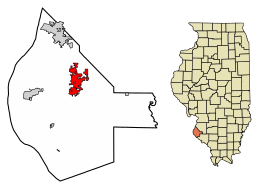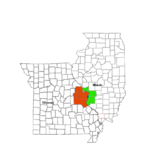
Sainte Genevieve County, often abbreviated Ste. Genevieve County, is a county located in the eastern portion of the U.S. state of Missouri. As of the 2020 census, the population was 18,479. The largest city and county seat is Ste. Genevieve. The county was officially organized on October 1, 1812, and is named after the Spanish district once located in the region, after Saint Genevieve, patroness of Paris, France.

Randolph County is a county located in the U.S. state of Illinois. According to the 2020 census, it had a population of 30,163. Its county seat is Chester.
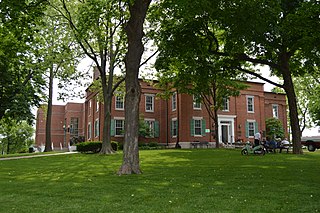
Monroe County is a county located in the U.S. state of Illinois. According to the 2020 census, it had a population of 34,962. Its county seat and largest city is Waterloo.

Wamac is a city in Washington, Marion, and Clinton counties in the U.S. state of Illinois. The population was 985 at the 2020 census, down from 1,185 in 2010. Incorporated as a city on July 25, 1916, Wamac derives its name from the three counties.

Staunton is the second largest city in Macoupin County, Illinois, United States. As of the 2020 census, the population was 5,054.

Highland is a city in Madison County, Illinois, United States. The population was 9,991 at the 2020 census. Highland began as a Swiss settlement and derived its name from later German immigrants.

Kell is a village in Marion County, Illinois, United States. The population was 173 at the 2020 census, down from 219 in 2010.

Walnut Hill is a village in Marion County, Illinois, United States. The population was 95 at the 2020 census.

Columbia is a city mainly in Monroe County with a small portion in St. Clair County in the U.S. state of Illinois, about 12 miles (19 km) south of St. Louis, Missouri. The population was 10,999 at the 2020 census.

Hecker is a village in Monroe County in the U.S state of Illinois. The population was 429 at the 2020 census, down from 481 in 2010.

Kaskaskia is a village in Randolph County, Illinois. Having been inhabited by indigenous peoples, it was settled by France as part of the Illinois Country. It was named for the Kaskaskia people. Its population peaked at about 7,000 in the 18th century, when it was a regional center. During the American Revolutionary War, the town, which by then had become an administrative center for the British Province of Quebec, was taken by the Virginia militia during the Illinois campaign. It was designated as the county seat of Illinois County, Virginia, after which it became part of the Northwest Territory in 1787. Kaskaskia was later named as the capital of the United States' Illinois Territory, created on February 3, 1809. In 1818, when Illinois became the 21st U.S. state, the town briefly served as the state's first capital until 1819, when the capital was moved to more centrally located Vandalia.

Red Bud is a city in Randolph County, Illinois, in the United States. The population was 3,804 at the 2020 census.
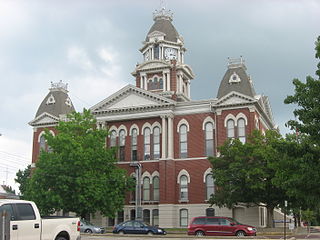
Shelbyville is a city in and the county seat of Shelby County, Illinois, United States, along the Kaskaskia River. As of the 2020 census, the population was at 4,674. HSHS Good Shepherd Hospital, located in town, is the county's only hospital. Shelbyville is also home to Chautauqua Auditorium.
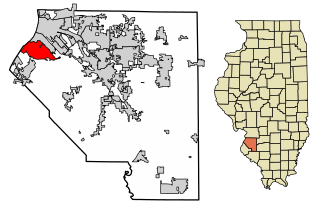
Cahokia is a settlement and former village in St. Clair County, Illinois, United States, founded as a colonial French mission in 1689. Located east of the Mississippi River in the Greater St. Louis metropolitan area, as of the 2010 census, 15,241 people lived in the village. On May 6, 2021, the village was incorporated into the new city of Cahokia Heights.
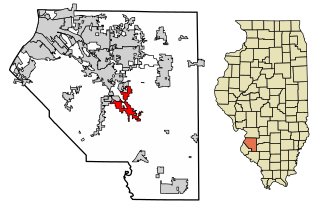
Freeburg is a village in St. Clair County, Illinois, United States. Located within Greater St. Louis, it is a southeastern exurb with many residents commuting to Downtown St. Louis or the Belleville area for employment. As of 2010, Freeburg had a population of 4,354.

Marissa is a village in St. Clair County, Illinois, United States. The population was 1,979 at the 2010 census.
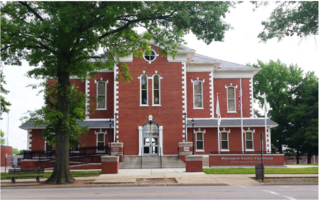
Nashville is a city in Washington County, Illinois, United States. As of the 2020 census, the city population was 3,105. It is the county seat of Washington County.

Herrin is a city in Williamson County, Illinois. The population was 12,352 at the 2020 census. The city is part of the Marion-Herrin Micropolitan Area and is a part of the Carbondale-Marion-Herrin, Illinois Combined Statistical Area with 123,272 residents, the sixth most populous Combined statistical area in Illinois.

Peterstown is a town in Monroe County, West Virginia, United States. The population was 456 at the 2020 census.

Hensley Township is a township in Champaign County, Illinois, USA. As of the 2020 census, its population was 1,033 and it contained 464 housing units.

